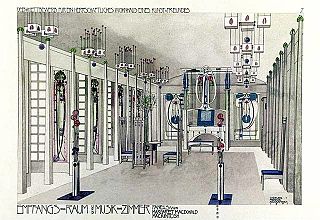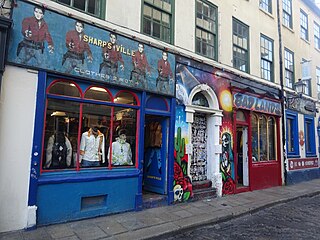
The hobby of collecting includes seeking, locating, acquiring, organizing, cataloging, displaying, storing, and maintaining items that are of interest to an individual collector. Collections differ in a wide variety of respects, most obviously in the nature and scope of the objects contained, but also in purpose, presentation, and so forth. The range of possible subjects for a collection is practically unlimited, and collectors have realised a vast number of these possibilities in practice, although some are much more popular than others.

An eponym is a person, a place, or a thing after whom or for which someone or something is, or is believed to be, named. Adjectives derived from the word eponym include eponymous and eponymic.

Americana artifacts are related to the history, geography, folklore, and cultural heritage of the United States of America. Americana is any collection of materials and things concerning or characteristic of the United States or of the American people, and is representative or even stereotypical of American culture as a whole.

Retro style is imitative or consciously derivative of lifestyles, trends, or art forms from the past, including in music, modes, fashions, or attitudes. In popular culture, the "nostalgia cycle" is typically for the two decades that begin 20–30 years ago.

Retrofuturism is a movement in the creative arts showing the influence of depictions of the future produced in an earlier era. If futurism is sometimes called a "science" bent on anticipating what will come, retrofuturism is the remembering of that anticipation. Characterized by a blend of old-fashioned "retro styles" with futuristic technology, retrofuturism explores the themes of tension between past and future, and between the alienating and empowering effects of technology. Primarily reflected in artistic creations and modified technologies that realize the imagined artifacts of its parallel reality, retrofuturism can be seen as "an animating perspective on the world".

An antique is an item perceived as having value because of its aesthetic or historical significance, and often defined as at least 100 years old, although the term is often used loosely to describe any object that is old. An antique is usually an item that is collected or desirable because of its age, beauty, rarity, condition, utility, personal emotional connection, and/or other unique features. It is an object that represents a previous era or time period in human history. Vintage and collectible are used to describe items that are old, but do not meet the 100-year criterion.

A couch, also known as a sofa, settee, chesterfield, or davenport, is a cushioned item of furniture that can seat multiple people. It is commonly found in the form of a bench with upholstered armrests and is often fitted with springs and tailored cushion and pillows. Although a couch is used primarily for seating, it may be used for sleeping. In homes, couches are normally put in the family room, living room, den, or lounge. They are sometimes also found in non-residential settings such as hotels, lobbies of commercial offices, waiting rooms, and bars. Couches can also vary in size, color, and design.

Fiesta is a line of ceramic glazed dinnerware manufactured and marketed by the Fiesta Tableware Company of Newell, West Virginia since its introduction in 1936, with a hiatus from 1973 to 1985. Fiesta is noted for its Art Deco styling and its range of often bold, solid colors.
Shabby chic is a style of interior design that chooses either furniture and furnishings for their appearance of age and signs of wear and tear or distresses new ones to achieve the same result. Unlike much genuine period décor, this style features a soft, pastel-colored, cottage look.

A chest is a form of furniture typically of a rectangular structure with four walls and a removable or hinged lid, used for storage, usually of personal items. The interior space may be subdivided.

Interior architecture is the design of a building or shelter from inside out, or the design of a new interior for a type of home that can be fixed. It can refer to the initial design and plan used for a building's interior, to that interior's later redesign made to accommodate a changed purpose, or to the significant revision of an original design for the adaptive reuse of the shell of the building concerned. The latter is often part of sustainable architecture practices, whereby resources are conserved by "recycling" a structure through adaptive redesign.
Since the advent of the cyberpunk genre, a number of cyberpunk derivatives have become recognized in their own right as distinct subgenres in speculative fiction, especially in science fiction. Rather than necessarily sharing the digitally and mechanically focused setting of cyberpunk, these derivatives can display other futuristic, or even retrofuturistic, qualities that are drawn from or analogous to cyberpunk: a world built on one particular technology that is extrapolated to a highly sophisticated level, a gritty transreal urban style, or a particular approach to social themes.

A girandole is an ornamental branched candle holder consisting of several lights that may be on a stand or mounted on the wall, either by itself or attached to a mirror. Girandole has been used to refer to a number of different objects and designs; the early girandoles were candelabras decorated with crystals looking like a chandelier on a stand, and at one time it was also used to describe all candelabras and chandeliers, with or without crystals. Girandole first appeared in France in the mid-17th century as a luxurious appliance for lighting. In the 18-century, a girandole may be attached to a mirror, and large wall-mounted girandoles with a mirror incorporated became fashionable in England in the second half of the 18th century. A form of girandole backed with a round convex mirror was also popular in the United States in the early 19th century.

Victoriana is a term used to refer to material culture related to the Victorian period (1837–1901). It often refers to decorative objects, but can also describe a variety of artifacts from the era including graphic design, publications, photography, machinery, architecture, fashion, and Victorian collections of natural specimens. The term can also refer to Victorian-inspired designs, nostalgic representations, or references to Victorian-era aesthetics or culture appropriated for use in new contexts

Vintage clothing is a generic term for garments originating from a previous era, as recent as the 1990s. The term can also be applied in reference to second-hand retail outlets, e.g. in vintage clothing store. While the concept originated during World War I as a response to textile shortages, vintage dressing encompasses choosing accessories, mixing vintage garments with new, as well as creating an ensemble of various styles and periods. Vintage clothes typically sell at low prices for high-end name brands.

Distressing in the decorative arts is the activity of making a piece of furniture or object appear aged and older, giving it a "weathered look". There are many methods to produce an appearance of age and wear. Distressing is viewed as a refinishing technique although it is the opposite of finishing in a traditional sense. In distressing, the object's finish is intentionally destroyed or manipulated to look less than perfect, such as with sandpaper or paint stripper. For example, the artisan often removes some but not all of the paint, leaving proof of several layers of paint speckled over wood grain underneath. This becomes the "finished" piece.
An Antique toy show is one of several toy shows held throughout the United States, usually on an annual basis, that is devoted to the exhibition, for sale, of antique toys, dolls and collectible paraphernalia. Toy shows are generally regional in nature, and cater to a certain geographic area of the country. The larger shows, such as the Miami Antique Toy Show and the Chicago Toy Show and the Greater Boston Antique and Collectible Toy Show encompass a broader clientele.

Nostalgia consumption is a social and cultural trend that could be described as the act of consuming goods that elicit memories from the past, being associated with the feeling of nostalgia.
Newtro (Korean: 뉴트로) is a portmanteau of the words "new" and "retro", and refers to the trend of "modernized retro". Newtro's beginnings can be traced back to 2018 in South Korea.

The Paris Apartment is a style of interior design where the focus is on the French boudoir and all things related to and inspired by French design and decor. The style incorporates all aspects of design, from the ceiling to the floor, walls and trims to the furniture, light fixtures, curtains, soft furnishings, books, and color palette. The boudoir furnishings used include chaise lounges, vanities, slipper chairs, beds, daybeds, nightstands, chandeliers, sconces, lamps, paintings, armoires, dressers, mirrors, and rugs. Each is hand crafted and all have worn, original painted patinas, traditional French details, and generally range in time period from 18th Century France through the Art Deco period. Treating these historic items as important heirlooms and caring for them as stewards is as important as the aesthetics themselves. The style includes other international items with character to complete the look so that it can be seen both as a collection and as a style of decoration reflecting one's individuality.
















